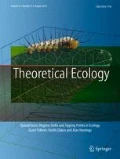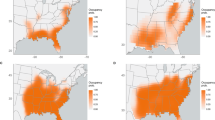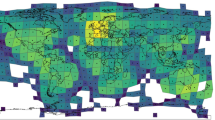Abstract
Assessing risks of local extinction and shifts in species ranges are fundamental tasks in ecology and conservation. Most studies have focused either on the border of species’ range or on complex spatiotemporal dynamics of populations within the spatial distribution of species. The internal properties of species ranges, however, have received less attention due to a general lack of simple tools. We propose a novel approach within a metapopulation framework to study species ranges based on simple mathematical rules. We formulate and test a model of population fluctuations through space to identify key factors that regulate population density. We propose that spatial variability in species abundance reflects the interaction between temporal variability in population dynamics and the spatial variability of population parameters. This approach, that we call range structure analysis, integrates temporal and spatial properties to diagnose how each parameter contributes to species occupancy throughout its geographic range.


Similar content being viewed by others
References
Arim M, Abades S, Neill P, Lima M, Marquet P (2006) Spread dynamics of invasive species. Proc Natl Acad Sci USA 103:374–378. doi:10.1073/pnas.0504272102
Bahn V, McGill BJ (2007) Can niche-based distribution models outperform spatial interpolation? Global Ecol Biogeogr 6:733–742. doi:10.1111/j.1466-8238.2007.00331.x
Balda RP, Bateman GC (1971) Flocking and annual cycle of the pion jay, Gymnorhinus cyanocephalus. Condor 73:287–302
Balda R, Kamil A, Bednekoff P (1997) Predicting cognitive capacities from natural histories: examples from four corvid species. Curr Ornithol 13:33–66
Bjørnstad ON, Stenseth NC, Saitoh T, Lindgjærde OC (1998) Mapping the regional transition to cyclicity in Clethrionomys rufocanus: spectral densities and functional data analysis. Res Popul Ecol 40:77–84
Brooks C (2006) Quantifying population substructure: extending the graph-theoretic approach. Ecology 87:864–872
Brown JH, Kodric-Brown A (1977) Turnover rates in insular biogeography—effect of immigration on extinction. Ecology 58:445–449
Brown JH, Mehlman DW, Stevens GC (1995) Spatial variation in abundance. Ecology 76:2028–243
Brown JH, Stevens GC, Kaufman DM (1996) The geographic range: size, shape, boundaries, and internal structure. Annu Rev Ecol Syst 27:597–623
Cabral JS, Schurr FM (2010) Estimating demographic models for the range dynamics of plant species. Global Ecol Biogeogr 19:85–97. doi:10.1111/j.1466-8238.2009.00492.x
Carter RN, Prince SD (1981) Epidemic models used to explain biogeographical distribution limits. Nature 293:644–645
Case TJ, Taper ML (2000) Interspecific competition, environmental gradient, gene flow, and the coevolution of species’ border. Am Nat 155:582–605
Clark CW, Rosenzweig ML (1994) Extinction and colonization processes: parameters estimates from sporadic surveys. Am Nat 143:583–596
Curnutt JL, Pimm SL, Maurer BA (1996) Population variability of sparrows in space and time. Oikos 76:131–144
Diamond JM, May RM (1977) Species turnover rates on islands: dependence on census interval. Science 197:266–270
Dias PC (1996) Sources and sinks in population biology. Trends Ecol Evol 11:326–330
Fortin M, Dale M (2005) Spatial analysis: a guide for ecologists. Cambridge University Press, Cambridge
Gaston KJ (2003) The structure and dynamics of geographic ranges. Oxford series in ecology and evolution. Oxford University Press, New York
Gonzalez A, Holt RD (2002) The inflationary effects of environmental fluctuations in source-sink systems. Proc Natl Acad Sci USA 99:14872–14877
Guo Q, Taper M, Schoenberger M, Brandle J (2005) Spatial-temporal population dynamics across species range: from centre to margin. Oikos 108:47–57
Harding KC, McNamara JM (2002) A unifying framework for metapopulation dynamics. Am Nat 160:173–85
Hanski I (1999) Metapopulation ecology. Oxford University Press
Hanski I, Ovaskainen O (2000) The metapopulation capacity of a fragmented landscape. Nature 404:755–758. doi:10.1038/35008063
Hengeveld R, Haeck J (1982) The distribution of abundance. I. measurements. J Biogeogr 9:303–316
Holland MD, Hastings A (2008) Strong effect of dispersal network structure on ecological dynamics. Nature 456:792–795. doi:10.1038/nature07395
Holt RD (1983) Lecture notes in biomathematics, chap. Models for peripheral populations: the role of immigration. Springer-Verlag, Berlin, pp 25–32
Holt RD (2003) On the evolutionary ecology of species’ range. Evol Ecol Res 5:159–178
Holt RD, Keitt TH (2000) Alternative causes for range limits: a metapopulation perspective. Ecol Lett 3:41–47
Holt RD, Keitt TH (2005) Species’ borders: a unifying theme in ecology. Oikos 108:3–6
Holt RD, Pickering J (1985) Infectious disease and species coexistence: a model of lotka-volterra form. Am Nat 126:196–211
Holt RD, Lawton JH, Gaston KJ, Blackburn TM (1997) On the relationship between range size and local abundance: back to basics. Oikos 78:183–190
Holt RD, Keitt TH, Lewis MA, Maurer BA, Taper ML (2005) Theoretical models of species? Borders: single species approaches. Oikos 108:18–27
Hosmer DW, Lemeshow S, May S (2011) Applied survival analysis: regression modeling of time to event data. Wiley, Hoboken
Jansen VAA, Yoshimura J (1998) Populations can persist in an environment consisting of sink habitats only. Proc Natl Acad Sci USA 95:3696–3698
Kawecki TJ, Holt RD (2002) Evolutionary consequences of asymmetric dispersal rates. Am Nat 160:333–347
Kearney M, Porter W (2009) Mechanistic niche modelling: combining physiological and spatial data to predict species’ ranges. Ecol Lett 12:334–350. doi:10.1111/j.1461-0248.2008.01277.x
Keitt TH, Urban DL, Milne BT (1997) Detecting critical scales in fragmentes landscapes. Conserv Ecol 1:4
Keymer JE, Marquet PA, Velasco-Hernández JX, Levin SA (2000) Extinction thresholds and metapopulation persistence in dynamic landscapes. Am Nat 156:478–494
Kirkpatrick M, Barton NH (1997) Evolution of a species range. Am Nat 150:1–23
Klimkiewicz MK, Futcher AG (1989) Longevity records of North American birds: supplement 1. J Field Ornithol 60:469–494
Labra F, Lagos NA, Marquet PA (2003) Dispersal and transient dynamics in metapopulations. Ecol Let 6:197–204. doi:10.1046/j.1461-0248.2003.00413.x
Levins R (1970) Some mathematical questions in biology, chap. Extinction, 77–107. American Mathematical Society, Providence
Liebhold AM, Rossi RE, Kemp WP (1993) Geostatistics and geographic information systems in applied insect ecology. Annu Rev Entomol 38:303–327. doi:10.1146/annurev.en.38.010193.001511
MacArthur RH (1960) On the relative abundance of species. Am Nat 94:25–37
MacArthur RH, Levins R (1964) Competition, habitat selection, and character displacement in a patchy environment. Proc Natl Acad Sci USA 51:1207–1210
MacKenzie D, Nichols JD, Royle JA, Pollock KH, Bailey LL, Hines JE (2005) Occupancy estimation and modeling: inferring patterns and dynamics of species occurrence. Academic, San Diego
Manel S, Schwartz MK, Luikart G, Taberlet P (2003) Landscape genetics: combining landscape ecology and population genetics. Trends Ecol Evol 18:189–197
Marzluff JM, Balda RP (1989) Causes and consequences of female-based dispersal in a flock-living bird, the Piñon jay. Ecology 70:316–328
Marzluff JM, Balda RP (1992) The Pinyon jay: behavioral ecology of a colonial and cooperative corvid. T. & A.D. Poyser, London
Maurer B, Brown J (1989) Distributional consequences of spatial variation in local demographic processes. Ann Zool Fenn 26:121–131
McGill B, Collins C (2003) A unified theory for macroecology based on spatial patterns of abundance. Evol Ecol Res 5:469–492
McRae BH, Beier P (2007) Circuit theory predicts gene flow in plant and animal populations. Proc Natl Acad Sci USA 104:19885–19890. doi:10.1073/pnas.0706568104
McRae BH, Dickson BG, Keitt TH, Shah VB (2008) Using circuit theory to model connectivity in ecology, evolution, and conservation. Ecology 89:2712–2724. doi:10.1890/07-1861.1
Morlon H, White EP, Etienne RS, Green JL, Ostling A, Alonso D, Enquist BJ, He F, Hurlbert A, Magurran AE, Maurer BA, McGill BJ, Olff H, Storch D, Zillio T (2009) Taking species abundance distributions beyond individuals. Ecol Lett 12:488–501. doi:10.1111/j.1461-0248.2009.01318.x
Pearman PB, Guisan A, Broennimann O, Randin CF (2008) Niche dynamics in space and time. Trends Ecol Evol 23:149–158. doi:10.1016/j.tree.2007.11.005
Peterson AT, Soberón J, Pearson RG, Anderson RP, Martinez-Meyer E, Nakamura M, Araùjo MB (2011) Ecological niches and geographic distributions. Princeton University Press, Princeton
Pulliam RH (1988) Sources, sinks, and population regulation. Am Nat 132:652–661
Ronce O (2007) How does it feel to be like a rolling stone? Ten questions about dispersal evolution. Annu Rev Ecol Syst 38:231–253. doi:10.1146/annurev.ecolsys.38.091206.095611
Royle JA, Link WA (2006) Generalized site occupancy models allowing for false positive and false negative errors. Ecology 87:835–841
Samaniego H, Srandour G, Milne BT (2012) Analyzing Taylors Scaling Law: qualitative differences of social and territorial behavior on colonization/extinction dynamics. Popul Ecol 54:213–223. doi:10.1007/s10144-011-0287-0
Sauer JR, Hines JE, Fallon J (2005) The north american breeding bird survey, results and analysis 1966–2005. Version 6.2.2006, Tech. rep. USGS Patuxent Wildlife Research Center, Laurel
Turelli M, Barton N, Coyne J (2001) Theory and speciation. Trends Ecol Evol 16:330–343
Venables WN, Ripley BD (2002) Modern applied statistics with S-PLUS, 3rd edn. Springer, New York
Williams CK, Ives AR, Applegate RD (2003) Population dynamics across geographical ranges: time-series analyses of three small game species. Ecology 84:2654–2667
Wintle BA, McCarthy MA, Parris KM, Burgman MA (2004) Precision and bias of methods for estimating point survey detection probabilities. Ecol Appl 14:703–712
Zhu Z, Evans D (1994) United states forest types and predicted percent cover from AVHRR data. Photogramm Eng Rem S 60:525–531
Acknowledgments
We thank Bruce T. Milne and Drew Allen for enlightening discussions. HS acknowledges the support of the US Department of Energy through the LANL/LDRD Program.
Author information
Authors and Affiliations
Corresponding author
Electronic supplementary material
Below is the link to the electronic supplementary material.
Rights and permissions
About this article
Cite this article
Samaniego, H., Marquet, P.A. Range structure analysis: unveiling the internal structure of species’ ranges. Theor Ecol 6, 419–426 (2013). https://doi.org/10.1007/s12080-013-0177-5
Received:
Accepted:
Published:
Issue Date:
DOI: https://doi.org/10.1007/s12080-013-0177-5




